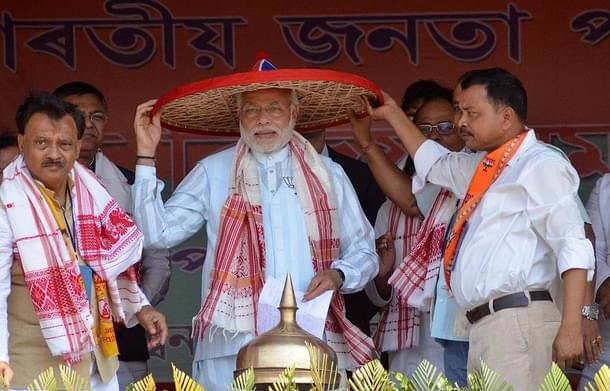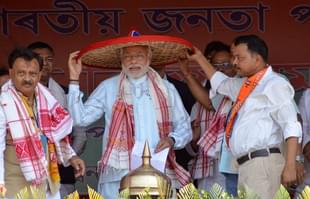Politics
Is The Congress Losing Ground In Assam To The BJP?
Jayant Chowdhury
Apr 03, 2016, 09:21 AM | Updated 09:21 AM IST
Save & read from anywhere!
Bookmark stories for easy access on any device or the Swarajya app.


Massive hoardings with the smiling visages of national and state-level political leaders line the road from Lokapriya Gopinath Bordoloi International Airport to Guwahati city. All the hoardings put up by the primary contenders for power in Assam—the BJP (and its allies—the Asom Gana Parishad and the Bodo Peoples’ Front), the Congress and the All India United Democratic Front—have slogans, some of them witty, urging Assam’s electorate to vote for the respective parties.
But two of them next to each other and displaying larger-than-life portraits of Sonia Gandhi, Rahul Gandhi and Assam’s incumbent and three-time Chief Minister Tarun Gogoi stand out—one asks what good have the countless visits of Narendra Modi and his cabinet ministers have done to Assam which is under-developed and mired in poverty.
This hoarding also displays the weather-beaten and hungry faces of some poor men and women of Assam. The next hoarding, which has the happy faces of well-fed and well-clothed people on it, claims that the Congress, which has ruled Assam for most of the years since Independence and for the last three terms, has wiped off poverty from the state and brought about development and prosperity.
The two contradictory hoardings are just one indication of the knots that the Congress has tied itself up in Assam. After ruling the state for fifteen long years, the Congress not only finds itself battling a strong anti-incumbency and charges of corruption and lack of development, but also a resurgent BJP which has taken the battle to the court of the Chief Minister.
That the Congress is on the backfoot is amply evident from the defensive election speeches of Congress’ ‘shehzada’, Tarun Gogoi and other Congress leaders and candidates. The BJP, whose leaders like Sarbananda Sonowal (the party’s Chief Ministerial candidate) and Himanta Biswa Sarma have been touring the state extensively and addressing six to seven well-attended election rallies a day, have been aggressively reminding the electorate of the little that the Congress has to show for the state in terms of development and progress. Gandhi, Gogoi and company have reduced themselves to defending themselves and their party’s poor track record in Assam.
Assam, which was the sixth most prosperous state in the country immediately after Independence, has seen its position slide down the index and is, today, one of the poorest and least developed states. This despite the fact that hundreds of thousands of crores of Rupees have been poured into the state for development and welfare projects over the last nearly seven decades. Unemployment is rife and with very little industrialization, the government remains the primary source of employment.
There has been no big-ticket private investment in the state over the last 15 years. The power situation has gone from bad to worse and the entire state, including its capital city Guwahati, goes without power for most of the day. The state health sector is in shambles after having shown signs of marked improvement during the tenure of Himanta Biswa Sarma as health minister (he was a senior Congress leader and close confidante of Gogoi, but quit the Congress over serious differences with the CM over the latter’s style of functioning, concentration of all powers in the CM’s hands and perpetuating dynastic rule in the state by foisting his son Gaurav in a leadership role over the heads of many senior and deserving Congress leaders).
The government-run schools and colleges in Assam lack even blackboards, not to talk of books and benches, and most of the best and brightest students from the state leave Assam for higher studies in the rest of the country, never to return again. This brain drain has become a major problem for the state.
Little has also been done to develop Assam’s vast potential—its plentiful natural resources, its rich flora and fauna, its multi-hued and wonderful culture and a lot more that the state has to offer. Assam’s two primary revenue earners—tea and oil, have not seen fresh investments in decades.
As a result, the price of Assam tea has plummeted and in the petroleum sector, little has been done to prospect for fresh reserves. Assam’s tourism potential is enormous, but here too little has been done to develop even basic tourist infrastructure. Most of the roads and bridges in Assam are a shame and public utilities are non-existent.
But the Congress, despite having very little to show for itself, has been winning elections in the state for decades. One of the main reasons for this is its practicing of vote-bank politics which has fuelled massive influx of Bangladeshi Muslims into the state.
Successive Congress governments in the state have not only turned a blind eye to this influx, but also actively encouraged it. This influx has led to an alarming change in the demographic profile of the state. According to the 2011 census, nine of Assam’s 27 districts, or a third of the state, has a majority Muslim population.
Ten years ago (as per the 2001 census), the number of such districts was six! Forty years ago, just two districts in the state had a majority-Muslim population! This “silent demographic invasion” (as former Assam governor Lt Gen S.K.Sinha termed it) has led to many geo-strategically located districts of the state bordering Bangladesh becoming Muslim-majority ones.
Dhubri district, for instance, lies along the border with Bangladesh and was, in 1961, a Hindu-majority district. In 2011, Hindus accounted for only 20 percent of the district’s population! Not only has the population of Muslims (and they’re all illegal migrants from Bangladesh) been increasing in this district, the numbers of Hindus have been falling sharply.
The decadal growth (2001 to 2011) of the Muslim population in India has been the highest in terms of percentage points in Assam—the state’s Muslim population rose from 30.9 percent to 34.2 percent, a growth of 3.3 points compared to the national average of 0.8 points.
In some districts away from the international border, this growth has been phenomenally high: the growth was 28.8 points in Darrang district, 14.88 points in Kamrup (which borders state capital Guwahati), 13.86 points in Nalbari and 11.37 points in Barpeta. This growth has been singularly attributed to illegal Muslim settlers from Bangladesh moving away from the border districts to the rest of Assam.
Experts fear that the Muslims—and almost all here are Bangladeshi Muslims who have entered the state illegally; Assam’s indigenous Muslims are a miniscule minority, don’t identify themselves with these illegal migrants, are a tolerant and secular lot and are as strongly opposed to the influx from Bangladesh as Assamese Hindus—would become a majority in Assam in another two decades.
These Bangladeshi Muslims, a very conservative lot who keep their women in burqas and want the enactment of the sharia (Islamic law), harbor many radical Islamists who, as state and central intelligence agencies have repeatedly reported, are in the payroll of Pakistan and are sleeper cells who’ll be activated to carry out jihadi strikes in future.
The Congress has allowed this massive influx in return for the votes of these migrants to win successive elections in the state and cling on to power. But in the process, it has thrust Assam into a highly dangerous and explosive situation.
The BJP has been accusing the Congress of creating this situation and this has struck a chord among the alarmed indigenous people of Assam who are facing the imminent threat of being reduced to a minority in their own state.
The BJP’s election campaign on the poor power situation in Assam, lack of development, unemployment and the state’s economy being in the doldrums has also struck a responsive chord among the people who are truly fed up with the sloth and inefficiency of the Congress that ruled Assam for the past fifteen years.
The Congress, thus running scared, has only been able to accuse the BJP of trying to divide the state on a communal basis. But this charge, coming from a party that stands accused of encouraging a silent demographic invasion of Assam from Bangladesh, rings hollow among Assam’s populace.
Jayant Chowdhury is an avid observer of and commentator on politics and society in Bengal and eastern, including north-eastern, India.





